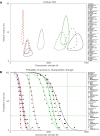Monolithic zirconia crowns: effect of thickness reduction on fatigue behavior and failure load
- PMID: 34777717
- PMCID: PMC8558575
- DOI: 10.4047/jap.2021.13.5.269
Monolithic zirconia crowns: effect of thickness reduction on fatigue behavior and failure load
Abstract
Purpose: The objective of this study was to evaluate the effect of thickness reduction and fatigue on the failure load of monolithic zirconia crowns.
Materials and methods: 140 CAD-CAM fabricated crowns (3Y-TZP, inCorisTZI, Dentsply-Sirona) with different ceramic thicknesses (2.0, 1.5, 1.0, 0.8, 0.5 mm, respectively, named G2, G1.5, G1, G0.8, and G0.5) were investigated. Dies of a mandibular first molar were made of composite resin. The zirconia crowns were luted with a resin composite cement (RelyX Unicem 2 Automix, 3M ESPE). Half of the specimens (n = 14 per group) were mouth-motion-fatigued (1.2 million cycles, 1.6 Hz, 200 N/ 5 - 55℃, groups named G2-F, G1.5-F, G1-F, G0.8-F, and G0.5-F). Single-load to failure was performed using a universal testing-machine. Fracture modes were analyzed. Data were statistically analyzed using a Weibull 2-parameter distribution (90% CI) to determine the characteristic strength and Weibull modulus differences among the groups.
Results: Three crowns (21%) of G0.8 and five crowns (36%) of G0.5 showed cracks after fatigue. Characteristic strength was the highest for G2, followed by G1.5. Intermediate values were observed for G1 and G1-F, followed by significantly lower values for G0.8, G0.8-F, and G0.5, and the lowest for G0.5-F. Weibull modulus was the lowest for G0.8, intermediate for G0.8-F and G0.5, and significantly higher for the remaining groups. Fatigue only affected G0.5-F.
Conclusion: Reduced crown thickness lead to reduced characteristic strength, even under failure loads that exceed physiological chewing forces. Fatigue significantly reduced the failure load of 0.5 mm monolithic 3Y-TZP crowns.
Keywords: Ceramics; Computer-aided design; Fatigue; Monolithic crowns; Zirconium.
© 2021 The Korean Academy of Prosthodontics.
Figures





References
-
- The American College of Prosthodontics. Facts & Figures 2021. [Accessed May 6, 2021]. Available from: https://www.gotoapro.org/facts-figures/
-
- Grand View Research Inc. Dental crowns & bridges market size worth $3.8 Billion By 2026 June 2019. [Accessed May 6, 2021]. Available from: https://www.grandviewresearch.com/press-release/global-dental-crowns-bri... .
-
- Zhao K, Pan Y, Guess PC, Zhang XP, Swain MV. Influence of veneer application on fracture behavior of lithium-disilicate-based ceramic crowns. Dent Mater. 2012;28:653–660. - PubMed
-
- Sailer I, Makarov NA, Thoma DS, Zwahlen M, Pjetursson BE. All-ceramic or metal-ceramic tooth-supported fixed dental prostheses (FDPs)? A systematic review of the survival and complication rates. Part I: Single crowns (SCs) Dent Mater. 2015;31:603–623. - PubMed
-
- Makhija SK, Lawson NC, Gilbert GH, Litaker MS, Mc-Clelland JA, Louis DR, Gordan VV, Pihlstrom DJ, Meyerowitz C, Mungia R, McCracken MS, National Dental PBRN Collaborative Group Dentist material selection for single-unit crowns: Findings from the National Dental Practice-Based Research Network. J Dent. 2016;55:40–47. - PMC - PubMed
LinkOut - more resources
Full Text Sources
Miscellaneous

